
|

| (Image: Infiltration)
|
Huge water infiltrations into concrete and reinforced concrete manholes can be sealed by injections in accordance with [DGEG86b] : - damming of water infiltrations by means of single-component polyurethane foam
- injection by means of two-component polyurethane resin
- second injection by means of two-component polyurethane resin.
|
|
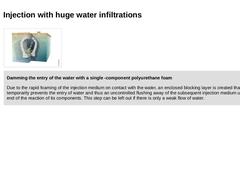
|

| (Image: Infiltration)
| |
Damming the entry of the water with a single -component polyurethane foam Due to the rapid foaming of the injection medium on contact with the water, an enclosed blocking layer is created that temporarily prevents the entry of water and thus an uncontrolled flushing away of the subsequent injection medium until the end of the reaction of its components. This step can be left out if there is only a weak flow of water. |
|
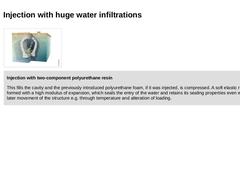
|

| (Image: Infiltration)
| |
Injection with two-component polyurethane resin This fills the cavity and the previously introduced polyurethane foam, if it was injected, is compressed. A soft elastic resin is formed with a high modulus of expansion, which seals the entry of the water and retains its sealing properties even with later movement of the structure e.g. through temperature and alteration of loading. |
|
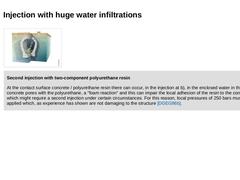
|

| (Image: Infiltration)
| |
Second injection with two-component polyurethane resin At the contact surface concrete / polyurethane resin there can occur, in the injection at b), in the enclosed water in the concrete pores with the polyurethane, a "foam reaction" and this can impair the local adhesion of the resin to the concrete, which might require a second injection under certain circumstances. For this reason, local pressures of 250 bars must be applied … |
|

|

|

|

|

|

Manholes perform a variety of functions, they are used to connect pipelines, to change direction and/or elevation, to provide access for personnel and/or equipment, and to provide aeration and ventilation to the drain and sewer system. This module covers crack repair in manholes using injection. After completing this module, you will have a sound knowledge of: - variations of filling cracks and
- crack filling materials and their properties.
|
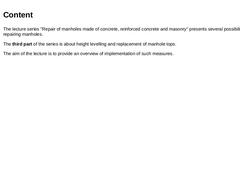
|

The lecture series "Repair of manholes made of concrete, reinforced concrete and masonry" presents several possibilities for repairing manholes. The third part of the series is about height levelling and replacement of manhole tops. The aim of the lecture is to provide an overview of implementation of such measures. |
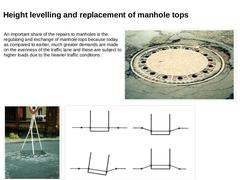
|

|
An important share of the repairs to manholes is the regulating and exchange of manhole tops because today, as compared to earlier, much greater demands are made on the evenness of the traffic lane and these are subject to higher loads due to the heavier traffic conditions . | (Image: Positional deviation of the frame of a manhole top [City of Düsseldorf, Germany])
| |
(Image: Manhole top raised above street level as a result of settling)
|
(Image: Possible … |
|
|
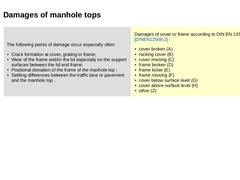
|

|
The following points of damage occur especially often: - Crack formation at cover, grating or frame;
- Wear of the frame and/or the lid especially on the support surfaces between the lid and frame;
- Positional deviation of the frame of the manhole top ;
- Settling differences between the traffic lane or pavement and the manhole top .
|
Damages of cover or frame according to DIN EN 13508 [DINEN13508-2] : - cover broken (A)
- rocking cover (B)
- cover missing (C)…
|
|
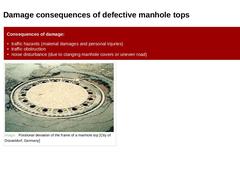
|

| Consequences of damage: - traffic hazards (material damages and personal injuries)
- traffic obstruction
- noise disturbance (due to clanging manhole covers or uneven road)
| | (Image: Positional deviation of the frame of a manhole top [City of Düsseldorf, Germany]) |
|

|

| The most common cause for the last two named types of damage is the failure of the grout between the frame of the manhole top and the throat of the manhole or possibly the support ring through a combination of dynamic loading from passing vehicles and chemical / physical stressing caused, for instance, by: - Effects of thawing salt;
- Temperature differences;
- Differences in moisture content;
- Freezing / thawing change stresses.
Further causes that can … |
|

|

| (Image: Suggestions for the rehabilitation of damages of manhole tops)
|
|
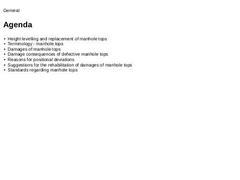
|

|

|

| (Image: Rehabilitation variants for height levelling)
|
|

|

|
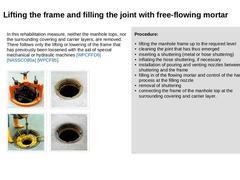
|

|
In this rehabilitation measure, neither the manhole tops, nor the surrounding covering and carrier layers, are removed. There follows only the lifting or lowering of the frame that has previously been loosened with the aid of special mechanical or hydraulic machines [WPCFFD6] [NASSCO85a] [WPCF85]. |
Procedure: - lifting the manhole frame up to the required level
- cleaning the joint that has thus emerged
- inserting a shuttering (metal or hose shuttering)
|
|
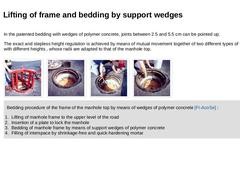
|

|
In the patented bedding with wedges of polymer concrete, joints between 2.5 and 5.5 cm can be pointed up. The exact and stepless height regulation is achieved by means of mutual movement together of two different types of wedges with different heights , whose radii are adapted to that of the manhole top. | |
(Image: Working sequence in the lifting of the frame of the manhole top by means of polymer concrete wedges [FI-AcoSe] - Lifting the manhole frame … |
|
|
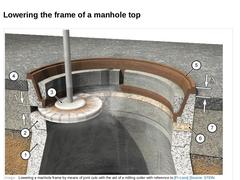
|

| (Image: Lowering a manhole frame by means of joint cuts with the aid of a milling cutter with reference to [FI-Loos] [Image: S&P GmbH])
|
|

|

|
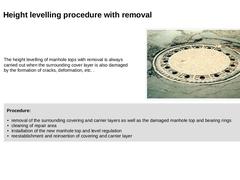
|

|
The height levelling of manhole tops with removal is always carried out when the surrounding cover layer is also damaged by the formation of cracks, deformation, etc. . | (Image: Positional deviation of the frame of a manhole top [City of Düsseldorf, Germany])
| |
Procedure: - removal of the surrounding covering and carrier layers as well as the damaged manhole top and bearing rings
- cleaning of repair area
- installation of the new manhole top and level regulation
|
|
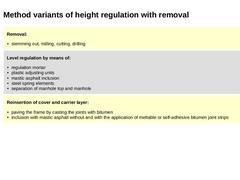
|

|
Removal: - stemming out, milling, cutting, drilling
| | |
Level regulation by means of: - regulation mortar
- plastic adjusting units
- mastic asphalt inclusion
- steel spring elements
- separation of manhole top and manhole
| | |
Reinsertion of cover and carrier layer: - paving the frame by casting the joints with bitumen
- inclusion with mastic asphalt without and with the application of meltable or self-adhesive bitumen joint strips
|
|
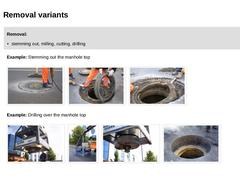
|

|
Removal: - stemming out, milling, cutting, drilling
| Example: Stemming out the manhole top |
(Image: Chiselling of the road surface in the manhole top region using a jackhammer)
|
(Image: Loosening the manhole frame from its support using the jackhammer)
|
(Image: Loosening the support ring using the jackhammer)
|
| Example: Drilling over the manhole top |
(Image: Manhole frame remover type "Shark")
|
(Image: Drilling out the asphalt cover using the manhole … |
|
|
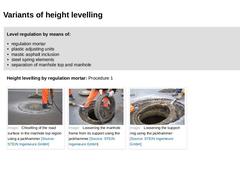
|

|
Level regulation by means of: - regulation mortar
- plastic adjusting units
- mastic asphalt inclusion
- steel spring elements
- separation of manhole top and manhole
| Height levelling by regulation mortar: Procedure 1 |
(Image: Chiselling of the road surface in the manhole top region using a jackhammer)
|
(Image: Loosening the manhole frame from its support using the jackhammer)
|
(Image: Loosening the support ring using the jackhammer)
|
|
|
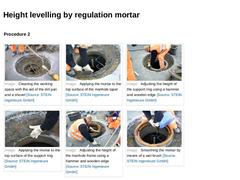
|

Procedure 2 |
(Image: Cleaning the working space with the aid of the dirt pan and a shovel)
|
(Image: Applying the mortar to the top surface of the manhole taper)
|
(Image: Adjusting the height of the support ring using a hammer and wooden edge)
|
|
(Image: Applying the mortar to the top surface of the support ring)
|
(Image: Adjusting the height of the manhole frame using a hammer and wooden edge)
|
(Image: Smoothing the mortar by means of a wet brush)
|
|
|